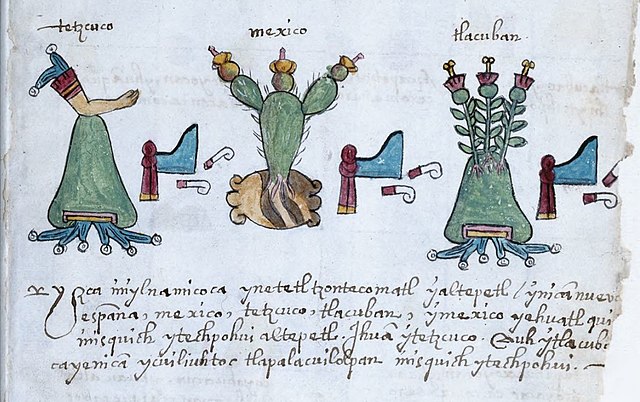Tetzcoco was a major Acolhua altepetl (city-state) in the central Mexican plateau region of Mesoamerica during the Late Postclassic period of pre-Columbian Mesoamerican chronology. It was situated on the eastern bank of Lake Texcoco in the Valley of Mexico, to the northeast of the Aztec capital, Tenochtitlan. The site of pre-Columbian Tetzcoco is now subsumed by the modern Mexican municipio of Texcoco and its major settlement, the city formally known as Texcoco de Mora. It also lies within the greater metropolitan area of Mexico City.
Tetzcotzingo Baths
Greenstone sculpture of a snake, from the National Museum of Anthropology.
Nezahualcoyotl as shown in the Codex Ixtlilxochitl, folio 106R, painted roughly a century after Nezahualcoyotl's death.
The altepetl was the local, ethnically-based political entity, usually translated into English as "city-state," of pre-Columbian Nahuatl-speaking societies in the Americas. The altepetl was constituted of smaller units known as calpolli and was typically led by a single dynastic ruler known as a tlatoani, although examples of shared rule between up to five rulers are known. Each altepetl had its own jurisdiction, origin story, and served as the center of Indigenous identity. Residents referred to themselves by the name of their altepetl rather than, for instance, as "Mexicas." "Altepetl" was a polyvalent term rooting the social and political order in the creative powers of a sacred mountain that contained the ancestors, seeds and life-giving forces of the community. The word is a combination of the Nahuatl words ātl and tepētl. A characteristic Nahua mode was to imagine the totality of the people of a region or of the world as a collection of altepetl units and to speak of them on those terms. The concept is comparable to Maya cah and Mixtec ñuu. Altepeme formed a vast complex network which predated and outlasted larger empires, such as the Aztec and Tarascan state.

Glyphs representing Texcoco, Tenochtitlan, and Tlacopan, the three primary altepetl of the Aztec Empire.
An illustration of the destruction of Indigenous codices by Franciscan friars by Diego Muñoz Camargo (1585)





